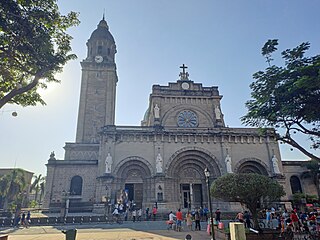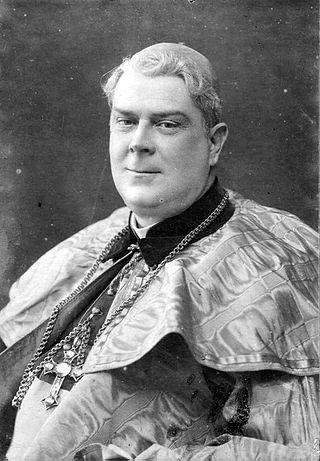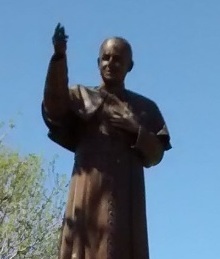
The Archdiocese of Manila is the archdiocese of the Latin Church of the Catholic Church in Metro Manila, Philippines, encompassing the cities of Manila, Makati, San Juan, Mandaluyong, Pasay, and Taguig. Its cathedral is the Minor Basilica and Metropolitan Cathedral of the Immaculate Conception, also known as the Manila Cathedral, located in Intramuros, which comprises the old city of Manila. The Blessed Virgin Mary, under the title Immaculate Conception, is the principal patroness of the archdiocese.

Adolfo Antonio Suárez Rivera was a Mexican cardinal in the Catholic Church who also served as Bishop of Tepic, Tlalnepantla and Archbishop of Monterrey.

Cristóbal Magallanes Jara, also known as Christopher Magallanes, was a Mexican Catholic priest and martyr who was killed without trial on the way to say Mass during the Cristero War. He had faced trumped-up charges of inciting rebellion.

The Claretians, officially named the Congregation of Missionary Sons of the Immaculate Heart of the Blessed Virgin Mary, is a Catholic clerical religious congregation of Pontifical Right for men headquartered in Rome. It was founded on July 16, 1849, by Fr. Antonio María Claret y Clará, C.M.F. They are active as missionaries worldwide, in 70 countries on five continents. The number of Claretian priests and brothers is at more than 3,000. The Congregation has a particular devotion to the Immaculate Heart of Mary and members have published extensively in Mariology.

Pelagio Antonio de Labastida y Dávalos was a Mexican Roman Catholic prelate, lawyer and doctor of canon law, and politician. He was a member of the imperial regency that invited Maximilian of Austria to accept the throne of Mexico.

Adolfo Alejandro Nouel y Bobadilla was an archbishop, educator and interim president of the Dominican Republic.

San Carlos and San Ambrosio Seminary is a seminary in Havana, Cuba.

Francisco Robles Ortega is a Mexican prelate of the Catholic Church, a cardinal since 2007 and the current Archbishop of Guadalajara. Cardinal Robles had previously served as archbishop of Monterrey from 2003 to 2011. He is also, as of November 2012, the incoming president-elect of the Roman Catholic Mexican Episcopal (Bishops') Conference, to replace the outgoing president, Archbishop Carlos Aguiar Retes, the Metropolitan Archbishop of the Roman Catholic Archdiocese of Tlalnepantla.

The Royal and Conciliar San Carlos Seminary is the archdiocesan seminary of the Roman Catholic Archdiocese of Manila. It was established in the year 1702, by decree of King Philip V of Spain. At present, the institution houses seminarians belonging to various dioceses in Luzon, particularly from the Metro Manila region.

The Roman Catholic Archdiocese of Tuguegarao is a Latin Church metropolitan archdiocese of the Catholic Church in the Philippines. Tuguegarao is a river delta city that became center of the archdiocese in the province of Cagayan, on the island of Luzon. Its seat is located at the Saint Peter the Apostle Metropolitan Cathedral.

Adalberto Almeida y Merino was a Mexican prelate of the Roman Catholic Church who served as Bishop of Tulancingo, 1956–1962; Bishop of Zacatecas, 1962–1969 and Archbishop of Chihuahua, 1969–1991.
The Colegio de San Ildefonso was an educational institution run by the Society of Jesus in Cebu City, Philippines in the then Spanish Captaincy General of the Philippines. It was established by the Jesuits in 1595 thus making it the first European-founded educational institution in Asia. In Mexico City, the Jesuits had founded a college with the same name in 1588. The Cebu City college was established by Fr. Antonio Sedeño, Fr. Pedro Chirino, and Antonio Pereira of the Society of Jesus in August 1595. After the expulsion of the Jesuits from Spanish territories in 1767, the buildings and facilities were taken over by the Diocese of Cebu, then by the Congregation of the Mission, and later by the Society of the Divine Word.
The Universidad de San Ignacio was a university in the city of Manila which existed during the Spanish colonial era in the Philippines. It was founded in 1590 and is one of the earliest educational institutions built by Europeans in East Asia when it was established by Spanish Jesuits headed by Fr. Antonio Sedeño, S.J. The school ceased its existence following the expulsion of the Jesuits in the archipelago in 1768.

Holy Rosary Minor Seminary is a Roman Catholic seminary or a house of formation for high school and college would-be priests run by the Archdiocese of Caceres in Naga City, in the Philippines.

The Universidad Juárez del Estado de Durango is a public research university in the state of Durango, Mexico. Founded in 1856 as a small state college, the university underwent a series of expansions over the course of the 19th and 20th centuries, emerging as a full-scale public research institute in the 1970s with the addition of a medical school and an institute of scientific research. Today the university is one of the largest in the state of Durango, with an enrollment of over 14,000 students.

Francisco de Aguiar y Seijas y Ulloa was a Spanish cleric and bishop, notable as bishop of Michoacán and archbishop of Mexico.

The Theological Seminary of Bogotá, commonly known as the Major Seminary of Bogotá is a Roman Catholic major seminary located in Bogotá, Colombia, and serving both the Archdiocese of Bogotá and the Diocese of Facatativá. With history dating back to 1581, it is the oldest seminary in the Americas, and today is the largest and most prominent seminaries in Colombia, with dozens of alumni having been appointed bishops, archbishops, and cardinals. In addition to religious leaders, two Colombian presidents have been associated with the seminary. José Manuel Marroquín, the 27th President of Colombia, studied there in the 1840s, and Miguel Abadía Méndez, who was president in the 1920s, taught Latin at the seminary in the early 20th century.

Colegio Mayor de San Bartolomé is a private Catholic pre-school, primary and secondary school, colonial of Plateresque style building, located in the Santa Fe district of Bogotá, Cundinamarca, Colombia. The co-educational school was founded on 27 September 1604 by the Archbishop of Bogota Bartolomé Lobo Guerrero and the Jesuits José Dadey, Martín de Funes, Juan Bautista Coluccini, Martín de Torres, Bernabé de Rojas, and Diego Sánchez. The school is managed by the Society of Jesus.

The San Damaso Ecclesiastical University is a catholic university erected by the Holy See in the Archdiocese of Madrid (Spain). It teaches Philosophy, Theology, Classical Philology, Canon Law and Religion Sciences with official validity in all the universities of the Catholic Church. Its name is taken from the Pope Damasus I.
The Seminario Regional del Sureste was a training center for future Latin-American Catholic priests with a tendency toward Liberation Theology and ended up being the principal hotbed for this group of Catholics who sought the integration of priests into the modern world by helping the poor, the indigenous, and the dispossessed, opposing the clerical tradition of finding alliances in pre-existing circles of power. In SERESURE, which was located in the city of Tehuacán in Puebla, Mexico, various Catholic prelates and priests were trained, not just from Mexico, but from all of Latin America. The seminary was founded in 1969 by the initiative of several bishops toward the southeastern and pacific sections of the country, and stayed open until 1990, the year in which it was closed for good on the orders of Noberto Rivera Carrera, who considered it a Marxist institution opposed to the dogmatic teachings of the Catholic Church.